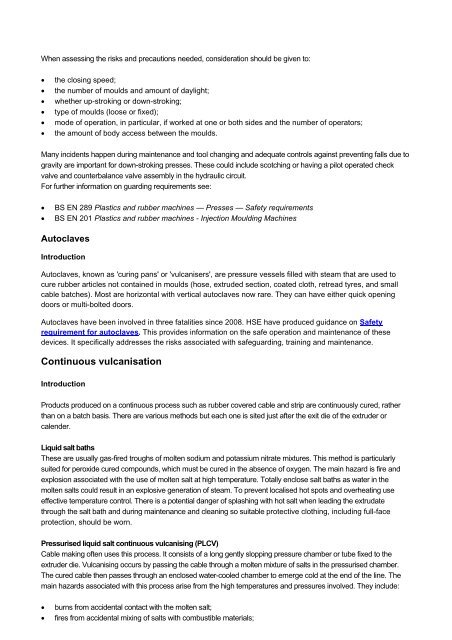Introduction to rubber processing and safety issues - HSE
Introduction to rubber processing and safety issues - HSE
Introduction to rubber processing and safety issues - HSE
You also want an ePaper? Increase the reach of your titles
YUMPU automatically turns print PDFs into web optimized ePapers that Google loves.
When assessing the risks <strong>and</strong> precautions needed, consideration should be given <strong>to</strong>:<br />
<br />
<br />
<br />
<br />
<br />
<br />
the closing speed;<br />
the number of moulds <strong>and</strong> amount of daylight;<br />
whether up-stroking or down-stroking;<br />
type of moulds (loose or fixed);<br />
mode of operation, in particular, if worked at one or both sides <strong>and</strong> the number of opera<strong>to</strong>rs;<br />
the amount of body access between the moulds.<br />
Many incidents happen during maintenance <strong>and</strong> <strong>to</strong>ol changing <strong>and</strong> adequate controls against preventing falls due <strong>to</strong><br />
gravity are important for down-stroking presses. These could include scotching or having a pilot operated check<br />
valve <strong>and</strong> counterbalance valve assembly in the hydraulic circuit.<br />
For further information on guarding requirements see:<br />
<br />
<br />
BS EN 289 Plastics <strong>and</strong> <strong>rubber</strong> machines — Presses — Safety requirements<br />
BS EN 201 Plastics <strong>and</strong> <strong>rubber</strong> machines - Injection Moulding Machines<br />
Au<strong>to</strong>claves<br />
<strong>Introduction</strong><br />
Au<strong>to</strong>claves, known as 'curing pans' or 'vulcanisers', are pressure vessels filled with steam that are used <strong>to</strong><br />
cure <strong>rubber</strong> articles not contained in moulds (hose, extruded section, coated cloth, retread tyres, <strong>and</strong> small<br />
cable batches). Most are horizontal with vertical au<strong>to</strong>claves now rare. They can have either quick opening<br />
doors or multi-bolted doors.<br />
Au<strong>to</strong>claves have been involved in three fatalities since 2008. <strong>HSE</strong> have produced guidance on Safety<br />
requirement for au<strong>to</strong>claves. This provides information on the safe operation <strong>and</strong> maintenance of these<br />
devices. It specifically addresses the risks associated with safeguarding, training <strong>and</strong> maintenance.<br />
Continuous vulcanisation<br />
<strong>Introduction</strong><br />
Products produced on a continuous process such as <strong>rubber</strong> covered cable <strong>and</strong> strip are continuously cured, rather<br />
than on a batch basis. There are various methods but each one is sited just after the exit die of the extruder or<br />
calender.<br />
Liquid salt baths<br />
These are usually gas-fired troughs of molten sodium <strong>and</strong> potassium nitrate mixtures. This method is particularly<br />
suited for peroxide cured compounds, which must be cured in the absence of oxygen. The main hazard is fire <strong>and</strong><br />
explosion associated with the use of molten salt at high temperature. Totally enclose salt baths as water in the<br />
molten salts could result in an explosive generation of steam. To prevent localised hot spots <strong>and</strong> overheating use<br />
effective temperature control. There is a potential danger of splashing with hot salt when leading the extrudate<br />
through the salt bath <strong>and</strong> during maintenance <strong>and</strong> cleaning so suitable protective clothing, including full-face<br />
protection, should be worn.<br />
Pressurised liquid salt continuous vulcanising (PLCV)<br />
Cable making often uses this process. It consists of a long gently slopping pressure chamber or tube fixed <strong>to</strong> the<br />
extruder die. Vulcanising occurs by passing the cable through a molten mixture of salts in the pressurised chamber.<br />
The cured cable then passes through an enclosed water-cooled chamber <strong>to</strong> emerge cold at the end of the line. The<br />
main hazards associated with this process arise from the high temperatures <strong>and</strong> pressures involved. They include:<br />
<br />
<br />
burns from accidental contact with the molten salt;<br />
fires from accidental mixing of salts with combustible materials;
















